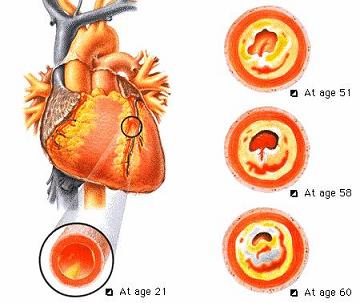Arteriosclerosis Causes. Atherosclerosis begins when certain fatty substances in the bloodstream--particularly cholesterol--form deposits on the inner lining of the arteries. Over a period of years, these deposits, called fatty streaks, enlarge and thicken to form plaques. The plaques have rough edges that irritate the smooth lining of the arteries, causing cells to die and scars to form. The build-up of dead cells, calcium, and scar tissue in the plaques makes the arteries hard and narrow, decreasing the flow of blood. The rough surface of the arteries may cause a thrombus (blood clot) to form on the arterial wall. A thrombus can block an artery suddenly.
Certain risk factors are associated with the development of atherosclerosis. Three major risk factors are hypertension (high blood pressure), cigarette smoking, and high blood levels of cholesterol. Others include obesity, physical inactivity, and diabetes mellitus.
|


